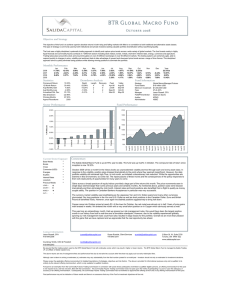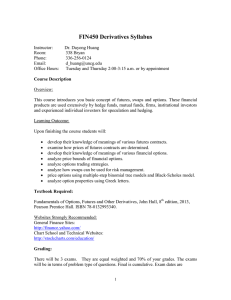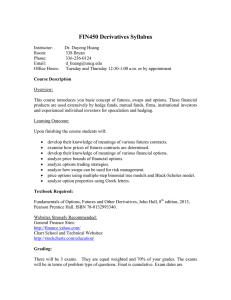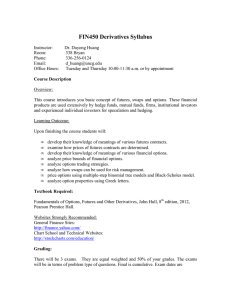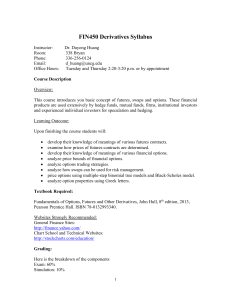G20 agricultural ministers ponder effects of rising food and commodity...
advertisement
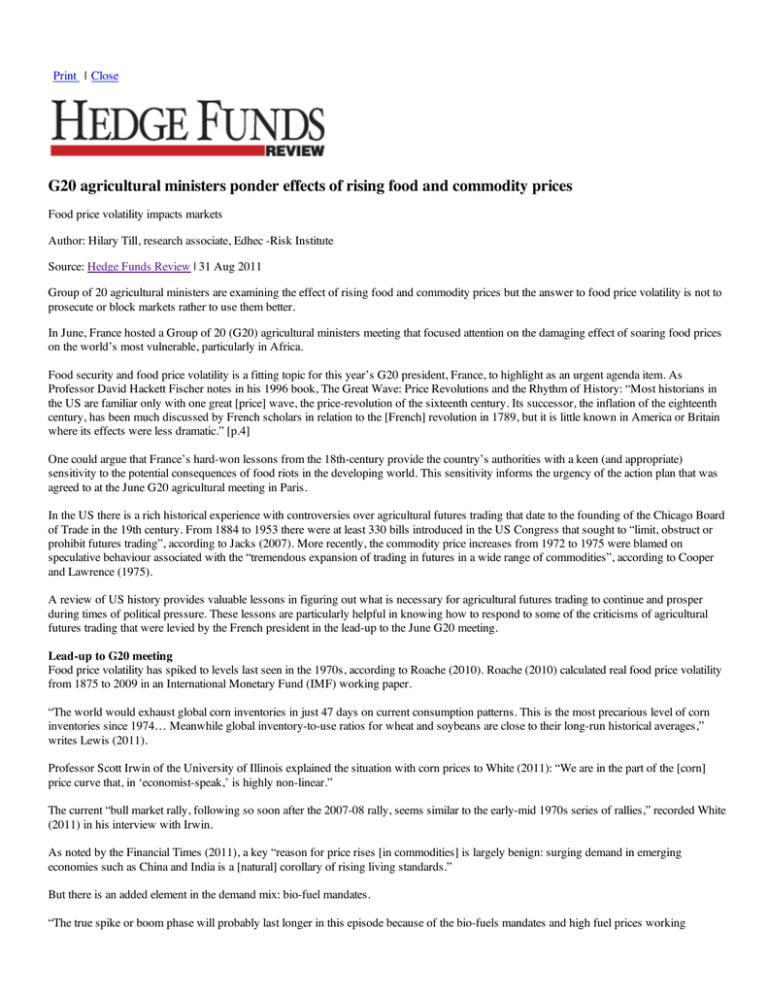
Print | Close G20 agricultural ministers ponder effects of rising food and commodity prices Food price volatility impacts markets Author: Hilary Till, research associate, Edhec -Risk Institute Source: Hedge Funds Review | 31 Aug 2011 Group of 20 agricultural ministers are examining the effect of rising food and commodity prices but the answer to food price volatility is not to prosecute or block markets rather to use them better. In June, France hosted a Group of 20 (G20) agricultural ministers meeting that focused attention on the damaging effect of soaring food prices on the world’s most vulnerable, particularly in Africa. Food security and food price volatility is a fitting topic for this year’s G20 president, France, to highlight as an urgent agenda item. As Professor David Hackett Fischer notes in his 1996 book, The Great Wave: Price Revolutions and the Rhythm of History: “Most historians in the US are familiar only with one great [price] wave, the price-revolution of the sixteenth century. Its successor, the inflation of the eighteenth century, has been much discussed by French scholars in relation to the [French] revolution in 1789, but it is little known in America or Britain where its effects were less dramatic.” [p.4] One could argue that France’s hard-won lessons from the 18th-century provide the country’s authorities with a keen (and appropriate) sensitivity to the potential consequences of food riots in the developing world. This sensitivity informs the urgency of the action plan that was agreed to at the June G20 agricultural meeting in Paris. In the US there is a rich historical experience with controversies over agricultural futures trading that date to the founding of the Chicago Board of Trade in the 19th century. From 1884 to 1953 there were at least 330 bills introduced in the US Congress that sought to “limit, obstruct or prohibit futures trading”, according to Jacks (2007). More recently, the commodity price increases from 1972 to 1975 were blamed on speculative behaviour associated with the “tremendous expansion of trading in futures in a wide range of commodities”, according to Cooper and Lawrence (1975). A review of US history provides valuable lessons in figuring out what is necessary for agricultural futures trading to continue and prosper during times of political pressure. These lessons are particularly helpful in knowing how to respond to some of the criticisms of agricultural futures trading that were levied by the French president in the lead-up to the June G20 meeting. Lead-up to G20 meeting Food price volatility has spiked to levels last seen in the 1970s, according to Roache (2010). Roache (2010) calculated real food price volatility from 1875 to 2009 in an International Monetary Fund (IMF) working paper. “The world would exhaust global corn inventories in just 47 days on current consumption patterns. This is the most precarious level of corn inventories since 1974… Meanwhile global inventory-to-use ratios for wheat and soybeans are close to their long-run historical averages,” writes Lewis (2011). Professor Scott Irwin of the University of Illinois explained the situation with corn prices to White (2011): “We are in the part of the [corn] price curve that, in ‘economist-speak,’ is highly non-linear.” The current “bull market rally, following so soon after the 2007-08 rally, seems similar to the early-mid 1970s series of rallies,” recorded White (2011) in his interview with Irwin. As noted by the Financial Times (2011), a key “reason for price rises [in commodities] is largely benign: surging demand in emerging economies such as China and India is a [natural] corollary of rising living standards.” But there is an added element in the demand mix: bio-fuel mandates. “The true spike or boom phase will probably last longer in this episode because of the bio-fuels mandates and high fuel prices working together,” continues Irwin in White (2011). Because of governmental policies mandating ethanol use, price may not function effectively to ration corn demand, a constraint that did not exist in the 1970s. Calculations of Working’s Speculative T index from 1947 to 2008 for the US agricultural futures markets Market Working 1954- Labys & Granger 58 (1) 1950-65 (2) Luethold 1969Peck 1947-71 (3) Peck 1947-71 (3) 80 (4) Corn 1.16 1.19 1.263-1.609 1.045-1.204 Soy beans 1.28 1.31 1.329-1.946 1.061-1.310 Soy bean oil 1..14 1.18 CBOT wheat 1.22 1.19 1.355-1.891 1.094-1.323 1.081-1264 1.009-1.045 KCBOT wheat Cotton 1.27 Live cattle 1.568-2.173 1.05-2.34 Feeder cattle 1.08-3.80 Lean hogs 1.10-8.69 Average 1.21 1.22 1.26-1.68 1.155-1.411 1.08-4.94 Source: Sanders et al. (2008), Table 10. Sources of prior calculations of Working’s Speculative T index along with notes on their calculation, as drawn from Sanders et al. (2008): 1 Working, H., 1960, “Speculation on Hedging Markets,” Food Research Institute Studies 1, pp. 185-220. “Non-reporting traders are allocated to hedging or speculating based on the levels of hedging and speculating in reported positions.” 2 Labys, W. and C. Granger, 1970, Speculation, Hedging and Commodity Price Forecasts, Lexington, MA: Heath Lexington Books. “Non-reporting traders are allocated to hedging or speculating based on the levels of hedging and speculating in reported positions following the method of Working (1960).” 3 Peck, A., 1980, “The Role of Economic Analysis in Futures Market Regulation,” American Journal of Agricultural Economics 62, p 1037-1043. “Peck estimates an upper (lower) bound by assuming all non-reporting traders are speculators (hedgers). The date range represents the most inclusive time period over which the index was calculated across the markets.” 4 Leuthold, R., 1983, “Commercial Use and Speculative Measures of Livestock Commodity Futures Markets,” Journal of Futures Markets 3, pp. 113-135. “Leuthold estimates an upper (lower) bound by assuming all non-reporting traders are speculators (hedgers). The date range represents the most inclusive time period over which the index was calculated across the markets.” Arezki and Brückner (2010) studied the consequences of increases in international food prices in an IMF working paper. The researchers examined over 120 countries from the period 1970 to 2007. They find that “for the low income countries increases in… international food prices significantly increase the incidence of anti-government demonstrations, riots, and civil conflicts.” This International Monetary Fund (IMF) study was particularly timely as it followed the 2007-08 food riots in some developing countries and preceded the Arab spring revolts, which in turn may have been fuelled by the fresh food price spikes that occurred at the beginning of this year. The latter point is according to AFP (2011). In the face of these challenges, timely and accurate information on crops from all producer nations would be very helpful, as noted in de La Hamaide and Maitre (2011), during the lead-up to the June G20 meeting. The 2007-08 food crisis may have been accentuated by the “export restraints implemented by [some] major grain exporting countries,” notes Dollive (2008). “The impact of export restraints… suggests that governments should use them cautiously.” This was another area of discussion in the lead-up to the G20 meeting. At a conference co-organised by the French Embassy in London on June 1, Pierre Jacquet, chief economist of the Agence Française de Développement, noted that a number of market-based solutions could potentially help developing countries better manage commodity price volatility, including increasing access to risk-hedging instruments. The World Bank announced on June 21 that it would take “the rare step of encouraging companies in developing countries to buy insurance in the derivatives markets against sudden changes in food prices”, reported Blas (2011). This deal, which was arranged with JP Morgan, would allow developing nations to hedge potentially $4 billion worth of commodities. According to Blas (2011): “The World Bank will underwrite $200 million in credit risk under the initiative while JP Morgan will take on a similar amount… this should enable countries to gain up to $4 billion in price protection. The institution said that other banks were likely to join later.” Blas’s report noted that Robert Zoellick, the World Bank president, said the agriculture price risk management tool showed what sensible financial engineering could do. The London June conference also addressed bio-fuel mandates. Richard Gower, a policy advisor for Oxfam UK, noted that developed countries should consider introducing “a price trigger so that when food prices are high, you divert those stocks of grains from fuel to food.” This proposal would address Irwin’s concern that, at least for corn prices, price might not serve its normal function of rationing demand in the face of current mandates. G20 action plan on food price volatility and agriculture On June 23 the G20 agricultural ministers agreed to an action plan to be presented at the G20 Cannes Summit in November. Essentially this plan includes a number of points: (1) co-ordinating further agronomic research; (2) extending access to risk-management hedging tools to companies in developing countries; (3) creating an international database of agricultural production, consumption, and inventories to enhance the quality of global food balance sheets; (4) instituting a rapid response international forum for dealing urgently with emerging food crises; (5) agreeing that export restrictions should not apply to humanitarian food aid; (6) creating targeted food safety nets for vulnerable populations; (7) researching the impact of bio-fuel mandates on food prices; (8) setting up regional emergency humanitarian food reserves; (9) strengthening the open and rules-based global trade system for agricultural products; (10) fostering “innovation in plant breeding, including by strengthening internationally agreed legal mechanisms for plant varieties”; (11) encouraging “efforts to establish proper investment environments, including through [the] improvement of law[s] and regulations” in developing countries; and (12) supporting appropriate regulation of agricultural derivatives trading, including enhancing the transparency of over the counter (OTC) derivatives trading and where appropriate establishing position limits. The action plan also documented the large number of multilateral organisations that contributed to its formulation and who would also be involved in carrying out the plan’s recommendations. Interestingly, the communiqué essentially embraced commodity derivatives trading because of the potentially valuable service that derivatives hedging can provide in managing price risk. Criticism of commodity derivatives trading In contrast to the benign view of commodity derivatives trading, French President Nicolas Sarkozy stated at the opening of the G20 meeting that “the financialisation of agriculture markets… is a contributory factor in price volatility” and that this was a priority issue for regulators to address. Ultimately whether agricultural futures trading increases price volatility (or not) is an empirical question. There is a way to reconcile political views on speculative futures trading with technical views on the usefulness of commodity futures hedging. Academic response to criticism of commodity trading Essentially, the historical lessons from past challenges to futures trading in the US are to: 1 Revisit constantly the economic usefulness of commodity futures trading. 2 Insist upon transparency in market-participation and position data in a sufficiently disaggregated fashion as to be useful, but also in a sufficiently aggregated fashion as to not violate individual privacy. 3 Carry out empirical studies to confirm or challenge the benefits and/or burdens of futures trading. 4 Employ strong regulatory monitoring and action to deter and prevent price manipulation. With each of these elements addressed, futures trading in the US has survived and prospered despite numerous challenges. In an Edhec-Risk position paper, Till (2009) discusses how potentially useful the Working T index is in evaluating the excessiveness or inadequacy of speculative participation in a commodity futures market. In order to be able to calculate this statistic, one needs complete transparency of prices and to be able to classify why a trader is involved in a market: is it for commercial hedging purposes or otherwise. The T index was created by the Stanford University economist, Holbrook Working, and is described in Working (1960). The Speculative T index specifically measures the excess of speculative positions beyond what is technically needed to balance commercial needs, and this excess is measured relative to commercial open interest. Historically, in the agricultural futures markets, there actually was an inadequacy of speculation to provide for commercial hedging needs. Sanders et al. (2008) write, “Working is careful to point out that what may be ‘technically an excess of speculation is economically necessary’ for a well-functioning market.” The levels of the T index can tell us whether speculative derivatives trading is excessive (or not) relative to commercial hedging needs, provided that we have the required transparency in market-participation and position data. This statistic enables us to reconcile the disparate views on whether speculative trading is excessive, or whether it is beneficial by providing liquidity for commercial hedgers. Irwin and Sanders (2011) note, “Utilizing Working’s speculative T index… the level of speculation in nine agricultural futures markets from 2006-2008 (adjusting for index fund positions) was not excessive… [and was] within the realm of historical norms [dating back to 1947.]” There is some empirical evidence to support the theory that speculative involvement actually reduces prices volatility. Brunetti et al (2011) examined five markets, including corn, over the period 2005 to 2009 and found that “speculative trading activity largely reacts to market conditions and reduces volatility levels, consistent with the hypothesis that speculators provide valuable liquidity to the market.” In addition Professor David Jacks of Simon Fraser University in Canada examined what happened to commodity-price volatility across countries and commodities before and after specific commodity-contract trading has been prohibited in the past. Jacks (2007) also examined commodity-price volatility before and after the establishment of futures markets, across time and across countries. Jacks’ study included data from 1854 to 1990. He generally, but not always, found that commodity price volatility was greater when there were not futures markets than when they existed, over one-year, three-year and five-year timeframes. More recently Irwin and Sanders (2011) note that “[commodity] index positions led to lower volatility in a statistical sense,” when examining 12 agriculture markets and two energy futures markets from June 2006 to December 2009. Specifically “there is mild evidence of a negative relationship between index fund positions and the volatility of commodity futures prices, consistent with the traditional view that speculators reduce risk in the futures markets and therefore lower the cost of hedging.” This brief review of evidence shows that futures trading, speculation and commodity index investment may have had a largely benign effect on price volatility. An interesting follow-up question to ask is: What did cause the periodic bouts of high volatility that were discussed in Roache (2010). Roache (2010) writes there have been four episodes of “increases in long-run food-price volatility” since 1885, “the first two occur during periods when global trade was impeded (the First World War and the inter-war years immediately following and the Second World War) … The next rise in volatility followed the breakdown of the Bretton Woods exchange rate regime in the early 1970s.” We are currently in the midst of the fourth episode of a notable increase in volatility. Roache (2010) finds two variables “explain a relatively large part of the rise in [low frequency] volatility since the mid-1990s: (1) the variation in US inflation and (2) the US dollar exchange rate. Conclusion Although the developed world’s focus in the last three years has been on the unfolding global financial crisis, the June G20 agricultural meeting in Paris appropriately brought attention to the damaging impact of food insecurity and food price volatility on developing countries. The meeting’s communiqué largely bypassed the controversy surrounding agricultural derivatives trading, and instead embraced market-based solutions in dealing with food price volatility, amongst its many action items. This paper notes that whether speculative derivatives trading has been excessive and has led to increased price volatility are empirical questions, which can be readily addressed whenever trading and market-participant data is publicly available. We would agree with the World Bank president who stated in Zoellick (2011) that “the answer to food price volatility is not to prosecute or block markets but to use them better”. US legislation and regulatory action to curb and monitor speculative activity in the commodity markets Date Regulation September 1921 Futures Trading Act Action The Act provides for the regulation of futures trading in grains, such as corn, wheat, oats and rye. The Act empowers the US Secretary of Agriculture to designate exchanges that meet certain requirements as “contract markets” in grain futures. The aim was to prevent market manipulation by the exchanges’ members, firms and employees. The Act also imposed a prohibitive 20 cents per bushel tax on all options trades and on grain futures trades that were not executed on a designated contract market as specified by the Federal Government. September 1922 Grain Futures Act The 1921 Futures Trading Act is declared unconstitutional. Instead of taxing futures and options trading, the 1922 Act bans off-contract-market futures trading. June 1923 The Grain Futures Exchange implements a larger trader reporting system. It requires each clearing member to report on a daily basis the market positions of each trader exceeding a specified size. February 1927 The Secretary of Agriculture suspends until November 1927 larger trader reporting requirements. This follows complaints that the requirements were preventing large bullish speculators from entering the market, thus allegedly depressing grain prices. Following the suspension, the Grain Futures Administration determines that larger trader reporting requirement did not discourage bullish speculators. June 1936 Commodity Exchange Act Following the collapse in grain and cotton prices during the 1930s, the CommodityExchange Commission (CEC) was established. The 1936 Act extends and strengthens the government’s regulatory powers to a longer list of commodities. The act provided for the adoption of position and trading limits to restrict the number of futures contracts that could be held by large individual speculators. It also prohibited the trading of options on commodities traded on futures exchanges December 1947 Amendment to the The Commodity Exchange Authority replaces the CEC. Following a rise in 1936 Commodity commodity prices after WWII, the Act allows the publication of the names and Exchange Act addresses and market positions of large traders. In its first declaration, the Secretary of Agriculture publishes the names of 35,000 traders. President Truman orders the CEA to require futures exchanges to raise margin requirements to 33% on all speculative positions. August 1958 October 1974 Onion Futures Act Trading in the Golden Globe onion futures contract on the Chicago Mercantile Exchange is banned. This followed excessive moves in the onion price during 1955. Commodity Futures Trading Commission Act The Commodity Futures Trading Commission (CFTC) is established. It extends the jurisdiction of the CFTC from agricultural commodities to futures trading in all commodities, which becomes effective in April 1975. August 1977 The CFTC requests the US district Court in Chicago to instruct the Hunt family of Dallas to liquidate positions that exceed 3 million bushels speculative position limit for soybean futures on the CBOT. March 1979 The CFTC votes to prohibit trading in the CBOT March wheat futures contract. This is the first time the Commission has ordered a market to close in the interest of preventing price manipulation. March 1980 After careful consideration, the CFTC votes not to use its emergency powers to order suspension of trading in silver futures as prices plummet. October 1981 Regulation 1.61 The CFTC requires exchanges to establish speculative position limits in all futures contracts. January 1991 The CFTC reports to Congress that it finds no evidence that the sharp rise in energy prices has been caused by manipulation or excessive speculation. August 2004 After a seven-month investigation, the CFTC concludes that there is no evidence that any entity or individual attempts to distort natural gas prices in late 2003. Summer 2009 The CFTC holds three public hearings to discuss speculative position limits and exemptions in energy markets. Source: Lewis (2009). Hilary Till, research associate at Edhec-Risk Institute, wrote this article. A Review of the G20 Meeting on Agriculture: Addressing Price Volatility in the Food Markets by Hilary Till, research associate, Edhec-Risk Institute, and principal, Premia Capital Management. Print | Close © Incisive Media Investments Limited 2010, Published by Incisive Financial Publishing Limited, Haymarket House, 28-29 Haymarket, London SW1Y 4RX, are companies registered in England and Wales with company registration numbers 04252091 & 04252093.
